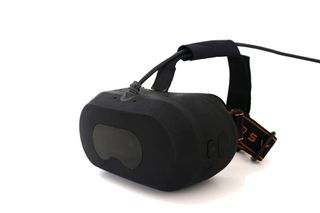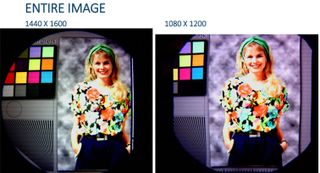Sensics Developed A High-Resolution VR HMD For Location Based VR Entertainment

Sensics revealed a new high-resolution VR HMD with ruggedized features designed to meet the needs of location based entertainment facilities. The new HMD also features a higher resolution than consumer headsets offer.
Consumer sales for virtual reality hardware may not have met the expectations of investors and some critics, but you would be hard pressed to make that argument about commercial facilities adopting VR. Location based VR entertainment facilities are popping up all over the world at a rapid pace.
HTC got behind the VR arcade concept with the Viveport Arcade commercial licensing platform and Valve also offers a commercial licensing program for SteamVR content. Several arcades have adopted HTC’s hardware, including the new Bandai Namco-sponsored VR-Zone Shinjuku, which offers a Mario Kart VR experience. Furthermore, several companies from around the world are working on large scale location based VR entertainment. Companies like The Void, which offers a Ghostbuster’s experience at Madame Tussaud’s in Time’s Square, and Zero Latency, which is about to open a facility (it’s ninth location) at the MGM Grand Hotel & Casino.
Curiously, these location-based VR entertainment facilities don’t offer superior hardware compared to what you can get for home. Obviously, the Vive-equipped facilities feature the Vive VR system, which you can have at home. The large-scale VR attractions often feature less impressive hardware.
The last time we touched base with The Void, the company was still struggling to develop its in-house Rapture HMD. We were initially told that the Rapture headset would debut alongside the Ghostbuster’s experience, but we later learned the company pushed forward with Oculus DK2 hardware instead. Zero Latency’s hardware is a little bit better, but if we’re honest, not by a lot. The company uses OSVR HDK2 headsets, which offers better resolution than the Oculus dev kits that The Void uses, but the HDK2 isn’t designed for consumer use—especially not in a commercial establishment. The HDK2 is among the most uncomfortable headsets we’ve tried on, so we were surprised to see it used for a commercial installation.




Location based VR entertainment facilities really need a headset that offers a better experience than you can get at home. Evidently, Sensics saw the gap in the market and went for it. The company revealed a new HMD (currently named Goggles for Public VR) that offers a premium visual experience and is built to withstand abuse.
“Our public VR products help operators deliver a premium guest experience,” said Yuval Boger, CEO of Sensics. “There is no longer need to accept the limitations of existing consumer products. Customers expect unique out-of-home VR experience. Sensics helps operators deliver the magic of VR at a higher level.”
Stay on the Cutting Edge
Join the experts who read Tom's Hardware for the inside track on enthusiast PC tech news — and have for over 25 years. We'll send breaking news and in-depth reviews of CPUs, GPUs, AI, maker hardware and more straight to your inbox.
Sensics offers its commercial headset with two different display options. You can get a 2160 x 1200 model, which is the same resolution as the HTC Vive, Oculus Rift, and OSVR HDK2. And now, you can also pick up a higher resolution model that boasts 2880 x 1600 pixels. Both headsets operate at 90Hz, but Sensics said the higher resolution model supports lower refresh rates if the host computer isn’t powerful enough to deliver 90Hz at that resolution.

The higher resolution is nice, but Sensics’ new headset has a lot more going for it than a better display. For example, Sensics’ public VR headset features hyper-allergenic face cushions that are easy to remove, reusable, and machine washable. The headset also includes two internal fans that help reduce sweating, and they keep the electronics and screens from developing condensation.
Perhaps the most interesting development about the new headset from Sensics is the interchangeable head strap system, which helps speed up the process of getting new players into the headset. Sensics’ solution allows users to put the head strap on without the HMD while they wait in line and then snap the HMD onto the head strap when they’re ready to play.
Sensics said that pre-production units of the high-resolution HMD are now available for $2,590 in “sample quantities.” Larger quantity orders should be available later this year.
Kevin Carbotte is a contributing writer for Tom's Hardware who primarily covers VR and AR hardware. He has been writing for us for more than four years.
-
Valantar Higher resolution displays and replaceable, washable, quick-swappable hypoallergenic cushions are all well and good, but that strap system is still sub-par at best. Straps like that are sufficient for ski goggles, not for a HMD weighing hundreds of grams.Either it'll slip, or you'll need massively uncomfortable clamping force on your cheeks and forehead to keep it in place. No thanks. The straps for the PSVR and the upcoming Windows HMDs look far superior.Reply -
nick.mok I would not call HMD with 2880x1600 high resolution.Reply
On the otherside of the world, a Chinese based HMD manufacturer already sent out their new HMD Dev Kits with 2*3840x2160 resolution + 200 FOV some months ago...
And with a much much affordable price compared to this $2,590 in the article.
http://www.pimaxvr.com/8k/
p.s. their hardware is not as good as Occulus and Vive acoording to some review.
Just want to point out that this the product mentioned in this article seems very lagged behind the competition. I mean most next generation of the Occulus and Vive will probably have higher resolution too. I am 99% sure they don't sell their HMD for $2,590 too. -
cryoburner Reply
Having resolution that high is not particularly useful if there are no graphics cards on the market that could push any sort of realistic graphics at that resolution while maintaining high refresh rates. By the time that sort of resolution would become viable, the rest of that hardware would be woefully outdated. And look at the size of that thing. Judging by its hammerhead-like appearance, it's most likely equipped with two smartphone screens side-by-side, which has to be unwieldy, and undoubtedly has a massive cable bundle which won't likely be going anywhere anytime soon.20131539 said:I would not call HMD with 2880x1600 high resolution.
On the otherside of the world, a Chinese based HMD manufacturer already sent out their new HMD Dev Kits with 2*3840x2160 resolution + 200 FOV some months ago...
Also, it's worth pointing out that while the site might repeatedly advertise it as "8K VR", that's purely false advertising. Two 4K screens do not equal 8K, since 8K is the equivalent of four 4K screens. You can't just put two 4K screens side by side and call it 8K.
As for the headset in this article, I'd certainly consider it to be "high resolution", since the resolution is significantly higher than what the leading VR headsets currently use. It's over 77% more pixels than the Oculus Rift and HTC Vive, which is the same difference between a 1080p and a 1440p display. As another point of comparison, 2880x1600 at 90fps is also pushing the same number of pixels per second as 4K at 50fps, so even this resolution would need high-level graphics hardware to provide a smooth experience, and going much higher than that wouldn't really be viable at this time. When those kinds of resolutions actually became viable for VR, they will undoubtedly be coupled with eye-tracking and foveated rending, allowing the graphics hardware to render only what the viewer is looking at at full resolution and detail levels, while spending less time rendering the periphery.
As for the cost, it's certainly priced higher than what any reasonable consumer should pay, but it's being sold to commercial VR installations, not home-users. In those scenarios, the added durability and quick-swap capabilities might be considered worth the added cost.
Most Popular

